eCommerce is a vast field that goes way beyond its scope of just buying and selling products/services over the web. Today, anyone with a smartphone and an internet connection can buy or sell anything. Does this mean we can apply eCommerce to all types of businesses? Read on to find out.
Many people think of eCommerce as online shopping, but it’s a narrow definition. While online shopping is essential to eCommerce, it goes way beyond that.
For example, ordering food online using UberEats or GrubHub is eCommerce. So is companies buying software from vendors, IT firms building software for the government, farmers selling produce to Walmart, or sellers listing their house on real estate websites. You can’t bind eCommerce in one definition because it applies to all types of businesses, be it B2B, B2C, B2G, C2C, or C2B.
Want to know how? Let’s have a look:
How eCommerce Applies in Different Sectors
1. Applying eCommerce for B2C Businesses
B2C is an evolving field in the eCommerce space. The B2C eCommerce market is expected to grow to $6.3 trillion by 2024, achieving nearly 22% of global retail sales, according to Statista.
The B2C eCommerce marketplace is well-established, with dozens of off-the-shelf platforms allowing B2C retailers to get up and running quickly.
Here are some major eCommerce applications in the B2C space:
A. Headless eCommerce
Most organizations rely on monolithic eCommerce architecture: a single solution takes a customer from their site visit to purchase. Customers today come to omnichannel vs. multichannel retail with high expectations that traditional eCommerce platforms fail to meet. The B2C eCommerce is evolving with a new option: “headless” eCommerce. Retailers are decoupling the front-end website from the backend to offer greater customization, personalization, and adaptability.
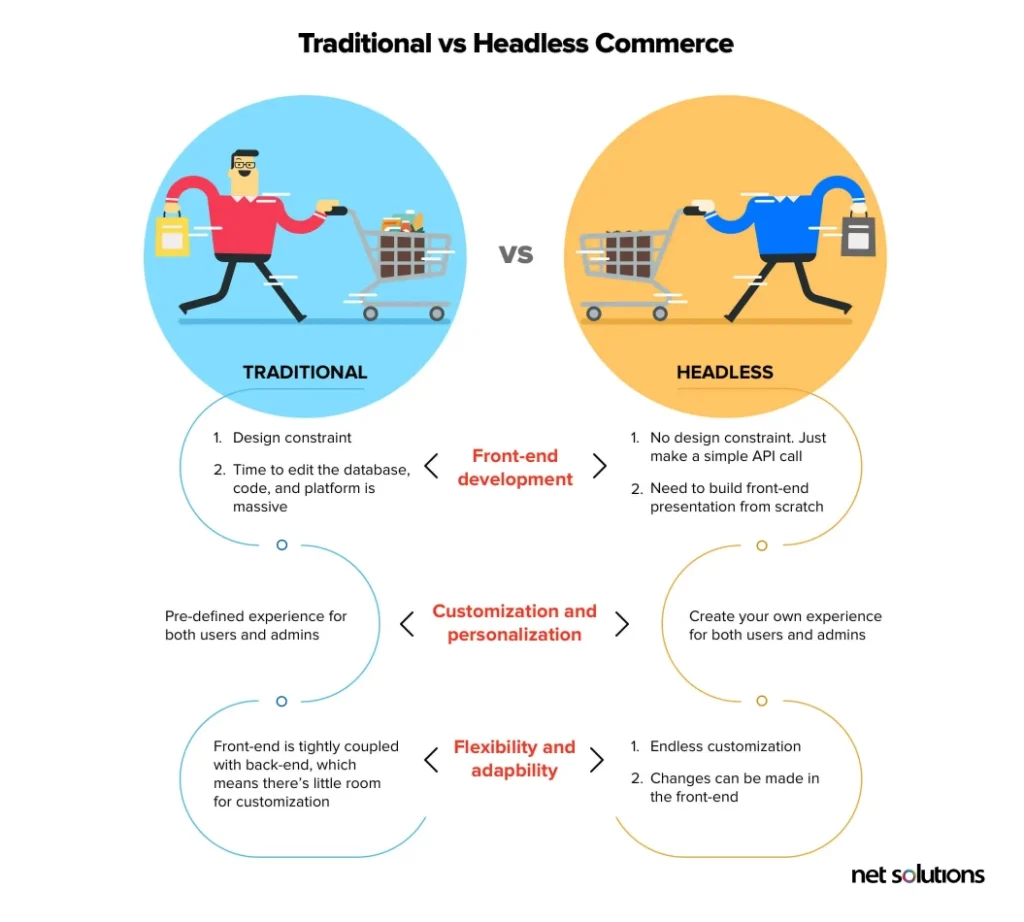
B. Omnichannel and multichannel retailing
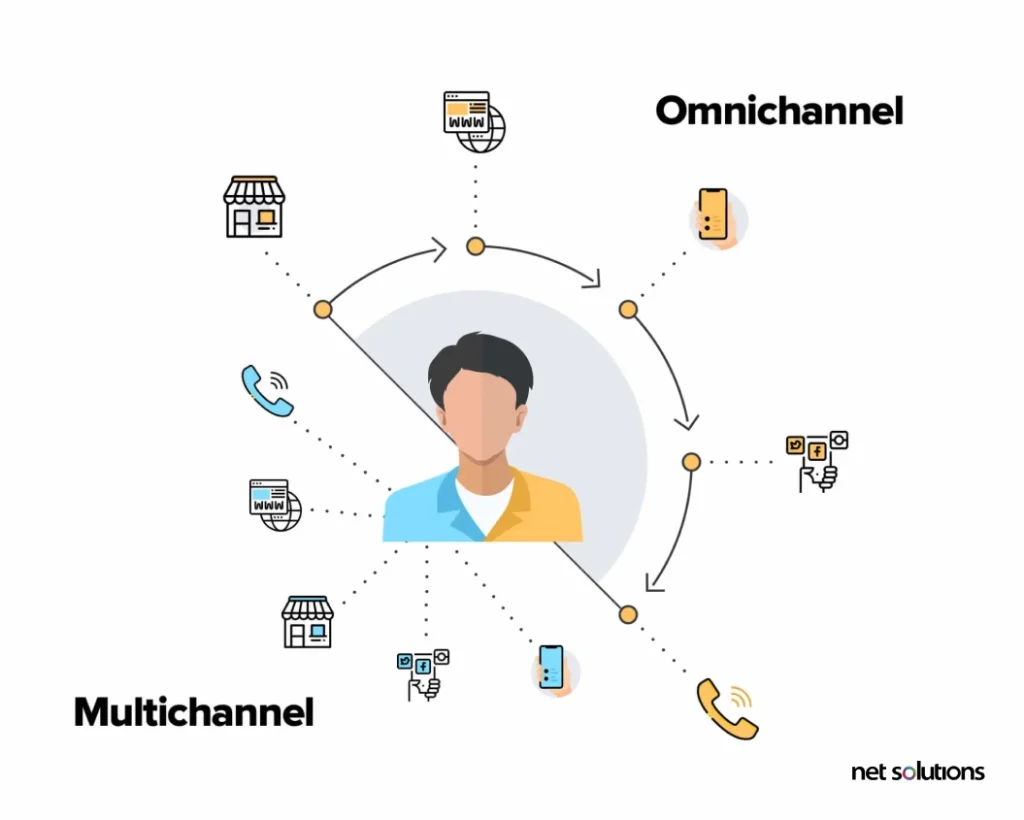
These days, most retailers sell products across many retail, online, and mobile channels. The approaches are called omnichannel and multichannel retailing and are essential to eCommerce.
Each channel is siloed with different stock and customer service teams in multichannel retailing. For example, in a multichannel framework, an item purchased online cannot be returned in-store. In another instance, an in-store buyer is given a coupon on their printed receipt that must be presented during their next in-person visit.
Omnichannel frameworks share one inventory and customer support experience. Omnichannel shoppers can use their mobile device to check stock for a particular store, check in-store and online purchases, or confirm loyalty points. They can buy a product directly on Pinterest without being redirected to another check-out site.
Today’s consumers interact with brands across a mix of channels, making it important to track data across the entire customer journey to personalize future interactions in real-time, no matter the channel they use.
C. Augmenting the High Street With eCommerce
The traditional “brick-and-mortar” retail environment, also called the “high street” and the eCommerce space, have been entirely separate for years. However, post the COVID pandemic, the boundaries are slowly blurring. Many retailers now offer “click and collect” sales options (from Starbucks to grocery, restaurant, and even apparel). The trend is evolving, and if we believe the numbers from eMarketer, click-and-collect sales will amount to 9.6% of retail eCommerce sales by 2025.
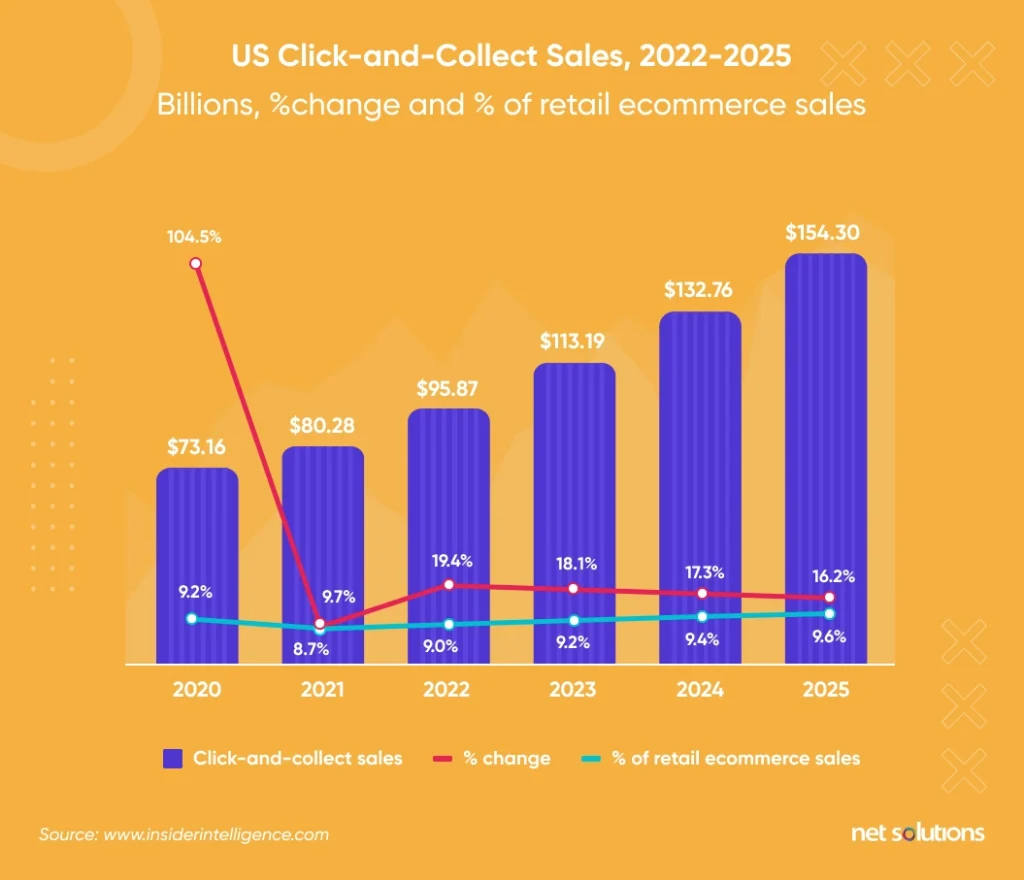
2. Applying eCommerce in B2B Sector
According to eMarketer, the B2B eCommerce market has achieved sales worth $1.77 trillion in 2022. B2B will be the most significant eCommerce growth sector in the next five years.
However, the B2B purchase decisions are not as immediate as those of a B2C purchase, with a typical B2B buyer conducting an average of 12 online searches before making a purchase. B2B businesses need to be innovative and smart in delivering experiences.
B2B companies must deliver the content, features, and experiences their buyers Automation plays a crucial role everywhere, including in the B2B landscape. By automating B2B transactions, businesses are saving business resources and time, ensuring frictionless payments, and enhancing control of payment processing. expect from their daily lives as B2C consumers.
— Accenture Interactive
As a result of this focus, a current 55% of the B2B marketing budget is focused on the digital experience on the eCommerce website. Brands are investing in content marketing efforts, personalization, self-service, and interactive features such as ROI calculators or video chats. Carefully structured eCommerce sites are giving businesses new ways to target key decision-makers precisely.
Here are a few other ways eCommerce is playing a key role in the B2B sector:
a. Omnichannel Experiences
Like the B2C space, B2B buyers also show an active interest in omnichannel experiences and expect the choice of in-person, remote, and eCommerce channels. To cater to this demand, many businesses have made omnichannel retailing an active part of their eCommerce strategy.
b. Social Commerce
According to eMarketer, 30% of all internet users in the United States complete purchases through social media. Moreover, Social commerce sales will probably triple by 2025. Seeing this, many businesses have set up their eCommerce stores on social media platforms like Facebook, Instagram, and Pinterest, from where they directly sell their products.
3. Applying eCommerce in B2G Sector
Business to government (B2G), also known as business-to-administration (B2A), is a larger market than many realize, with spending by the public sector at the local, state, and federal levels.
The US federal government spends over 18 billion daily on goods and services.
– The United States Treasury Data Lab
Also, Gartner forecasts the global government IT spending in 2022 to reach $565.7 billion, a 5% increase from 2021.
Although the private sector mainly supplies the government through a formal request for proposal (RFP) bidding process, eCommerce is becoming increasingly relevant. eCommerce in the B2G sector works in the reverse of most other sectors, with the government supporting the eCommerce platform to put projects out for tenders and applications and to facilitate the ongoing exchange of information. In this scenario, there is great pressure for eCommerce solutions that keep data secure.
One prominent example of eCommerce in B2G is the company Boeing which produces commercial and military aircraft, weapons systems, strategic defense and intelligence systems, and related products and services. The US government is one of its largest customers.
4. Applying eCommerce in C2C and C2B Sectors
In the consumer-to-consumer (C2C) and consumer-to-business (C2B) models, the consumer acts as the seller of the good or service and as the consumer of the third-party eCommerce platform.
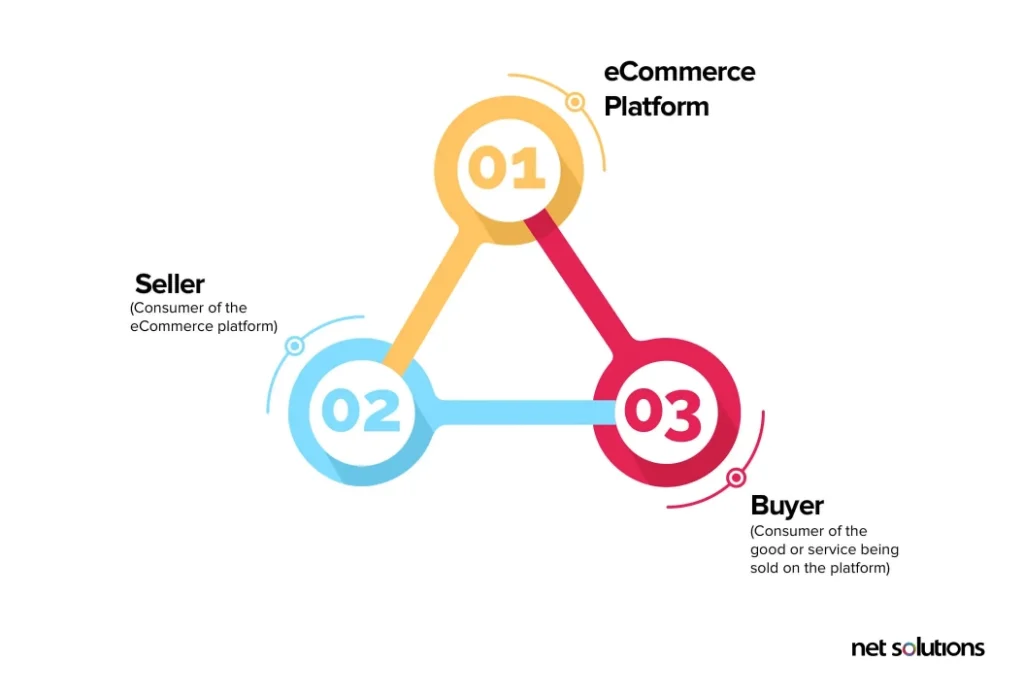
Online marketplaces such as Craigslist, eBay, and Facebook Marketplace are examples of C2C eCommerce. In these examples, Craigslist, eBay, and Facebook are intermediaries providing the eCommerce platform for the buying and selling of products between consumers. The C2C marketplace provides sellers with a way to get their products on the marketplace with no up-front investment in their eCommerce solution or retail store.
In the C2B model, end users (consumers) create products or services for the business market. The C2B model is very common in the job market, with sites such as Upwork allowing consumers to advertise their skills for hire by businesses. Affiliate marketing (where a website owner includes an affiliate link to an eCommerce website in a post) is another example of C2B eCommerce, as the writer is compensated for facilitating a sale.
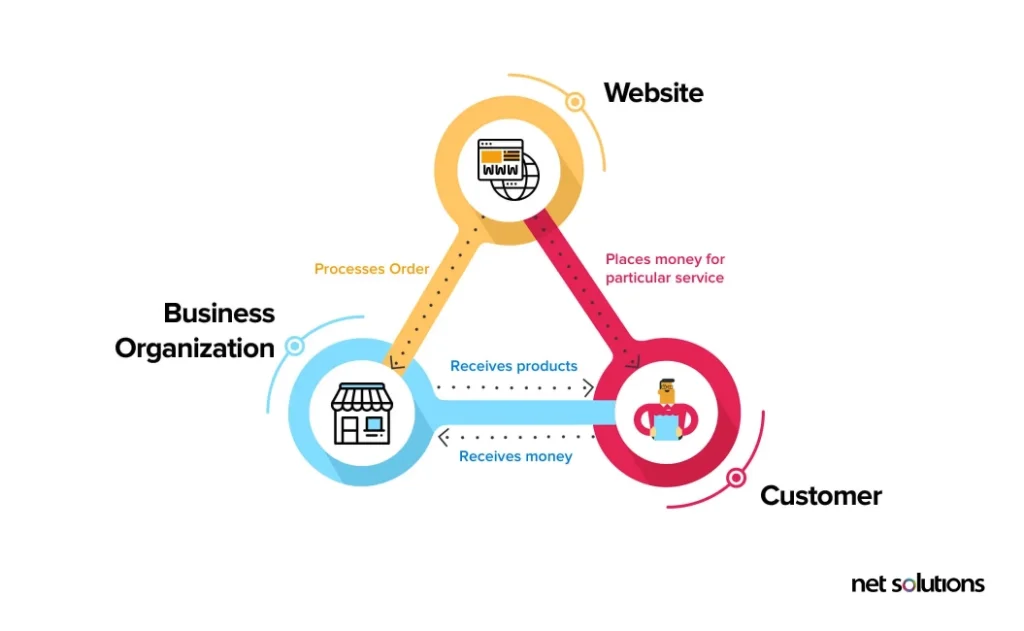
How can NetSolutions Build the Right eCommerce Solution for You?
Building right eCommerce solutions is challenging. It needs choosing a technology partner who has the right resources and significant expertise in eCommerce app development. Net Solutions has two decades of experience building strategic and result-oriented commerce apps and platforms. We understand all the elements of a successful eCommerce strategy, from branding and storytelling to design, optimization, and technology. We can optimize ready-made platforms like Magento and WooCommerce and create custom digital experiences. You can rely on us to build a secure and scalable eCommerce platform that signific boosts your sales.
Frequently Asked Questions
1. What are the major limitations of eCommerce?
Security, lack of privacy, tax issues, high labor costs, and legal issues are some major limitations of eCommerce.
2. What is the difference between e-commerce and e-business?
Performing online commercial activities and transactions over the internet is called eCommerce. On the other hand, eBusiness refers to performing all type of business activities through internet.
3. Why do eCommerce businesses fail?
Poor web design, lack of investment, poor checkout process, no marketing plans, and failing to meet user needs are some major reasons why most eCommerce businesses fail.
4. What is the next big thing in eCommerce?
AI, machine learning, Internet of Things (IoT), AR/VR are some trends amassing popularity in the eCommerce space.
SHARE THIS POST
Table of Contents
Related Resources
- eCommerce App Development Cost: Budgeting In-Depth Guide
- 13 Differences Between B2B and B2C eCommerce Websites
- Top 10 eCommerce Challenges and Easy Ways to Overcome Them
- 3 Types of eCommerce Business Models That Work in 2024
- eCommerce Customer Journey Mapping - The Secret to Higher Conversion Rates
- What is Headless Commerce? The Ultimate Guide
- Top 15 eCommerce KPIs to Track the Performance of Your Online Business
- What is Adobe Commerce (Magento)? Everything You Need to Know in 2024
- Why Your Business Needs a Mobile eCommerce App
- Omnichannel Retail Strategy: A Comprehensive Guide
- Omnichannel vs Multichannel Retailing: The Complete Guide
- What is eCommerce Order Fulfilment? (And 6 Steps to Improve the Process)
- PCI Compliance: Everything You Need To Know
- The BEST Guide to eCommerce Personalization
- 12 Essential Factors for Choosing the Best eCommerce Platform
- The Ultimate Guide to Product Information Management (PIM) Systems for Ecommerce
- What is a Product Recommendation Engine (And How it Helps Boost Sales)
- eCommerce Replatforming: Challenges, Benefits, and Best Practices
- The Ultimate Guide to eCommerce Security
- Top 13 eCommerce Trends in 2024
- How Voice Search will Transform the Future of eCommerce
- What is Web Accessibility (And Why it Matters for Your eCommerce Business)

